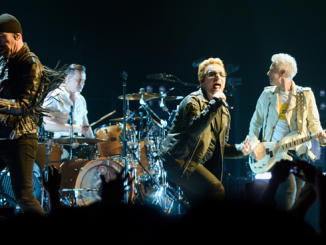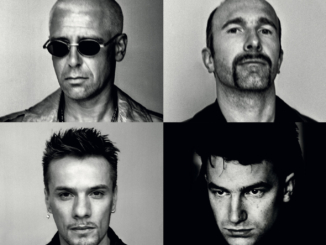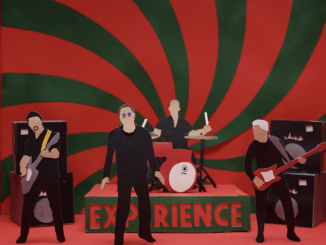
For those too young to have been there and for those of us getting too old to remember, I want to pause a moment and go back to a time when U2 was not only the Biggest Band in the World but were also one of the more audacious bands that could still ride atop the crest of popular culture.
In 1993 following up the monolithically popular Achtung Baby, the band had released the mind-bending Zooropa which had set listeners a whirl with its techno Avant-Garde stylings. Taking things a step farther into the esoteric the band under the moniker Passengers decided to wreak more havoc with expectations and released Original Soundtracks Part 1. So with over 20 years since its creation, it feels like a good time to re-examine a long-overlooked release.
U2 Producer and Techno/Electronica maestro Brian Eno formed Passengers with U2 as a musical warm-up exercise to lead the band into the making of what would be their 1997 album POP. Originally the purpose of the project was to record a soundtrack for the Peter Greenaway film, “The Pillow Book”. The project did not come to fruition for one reason or another. However, it gave Eno the idea to continue with the premise. He suggested that the band continue recording with imaginary films in mind. The exercise produced 14 tracks with 3 songs that were accompaniments to actual movies and 11 tracks which were created for movies that only exist in U2 and Eno’s imaginations. Eno in cajoling the band to participate in the venture pointed out that this effort was more of a spoof than any attempt to release a successful commercial venture. The band bought into the concept and hit the ground running.
To motivate the band Eno had them free form jam to video clips from various movies. He was very excited with the result and brought in Howie B. to cut and mix the tracks down to a manageable size. Eno and the band envisioned the release as a continuation of the trend that had begun with Zooropa where they attempted to create “visual music”. Also ingrained in the project was the idea that the visual suggestion of music was more important than the lyrics; mood and styling over lyrics and structure. Everything was also changed up with the band responsibilities.
For all intents and purposes, Larry Mullen Jr. was not allowed near his drums and instead worked on rhythm sequences and tracking machines. Edge’s distinctive guitar work was not allowed, and he worked with synths and keyboards, and Bono recognizable vocals were altered and muffled on almost every track. The only person allowed near his instrument of choice was Adam Clayton who as payment for that privilege had to do vocal chores on the track Your Blue Room, leaving many to say it is good Adam is a great bass player.
Response to the release was muted at best, as it became an oddity that only hardcore fans responded to with any kind of zeal. That is understandable considering the fact that the songs on the release with the exception of Miss Sarajevo are miles and miles away from what U2 does on their named recordings. More than ½ the album was instrumentals and the tracks were a departure from the structures and hooks that U2 produces. The album is the least popular and poorest seller of U2’s catalogue.
Larry Mullen has been quite vocal about his dislike of the album stating in 2002, “There’s a thin line between interesting music and self-indulgence. We crossed it on the Passengers record.” He also stated, “It hasn’t grown on me, however, Miss Sarajevo is a classic.” Bono ever the jokester stated in response to Larry’s objections to the project that,” Larry just didn’t like it because we didn’t let him play the drums.” The public, when asked for its opinion, weighed in on Larry’s side. Miss Sarajevo is the one exception, and was very successful and is still performed by the band live, it competed for the #1 spot when released with Michael Jackson’s “Earth Song” and appeared on U2’s Best of 1990-2000 compilation album.
Original Soundtracks Part I is best described sonically as in parts soothing, flowing, and occasionally jarring. The songs Slug, Always Forever Now and United Colours have an overarching time and space connection. They are each ambient, oscillating and filled with glistening techno beats. Your Blue Room has a more familiar U2 sound that harkens to songs that would appear later like If You Wear That Velvet Dress off POP and No Line on the Horizon’s Cedars of Lebanon. It is filled with a lovely bassline, and glistening guitar chords and keyboards. Also never to be missed was Adam’s reading of the last verse of the song.
Other noteworthy tracks are Ito Okaski, Elvis Ate America and the Theme From Lets Go Native. On Ito Okaski the haunted singing of Japanese vocalist Holi is a treat that makes for a song that is crystalline like a bell. Elvis Ate America is Bono doing a masterwork rhyming session on the topic of Elvis that slides off into something else quite arresting. It is a discourse on the 15 minutes of fame trope and filled with a southern Spiritual /Blues sound looped through the computer processor. Theme From Lets Go Native is noteworthy for being the harbinger of what was to come on POP, where an inkling of the song Mofo and The Fly peeks through. As you listen to the album you will catch yourself checking to see if this is really U2 performing but the change-up in expectations makes the whole listening exercise very intriguing.
Finally let us never forget the reason why anyone owns the recording, Miss Sarajevo. This absolutely stunning song is found amid the flotsam of the album and was written with an actual film as inspiration. It is heartbreakingly tragic, majestic and filled with drama. To bring that drama to fruition it didn’t hurt that Luciano Pavarotti contributed his vocals to the final verse pushing it emotionally over the top. As Mr Mullen has stated it is a classic.
One thing that is striking about the album is that it has made more sense and become more appealing the farther away listeners get from the time of its original creation. It provides a heads up and guideposts to the pre-development period of POP. It allowed the band to cleanse their palette by allowing them to be completely anti-pop in song structuring before jumping into the recording of POP. Even if the album never took off it is filled with a number of worthy selections that showed that the band was able to think outside the box. It displayed the members of the band evincing mad electronica abilities. For U2 admirers it can be reassuring to know that if the World’s Biggest Rock Band meme hadn’t worked out for the guys they could have possibly had a nice career in the Electronica/Dance House genre.
I highly recommend that U2 fans who own it dust the disc off and give it another go, you will find much to like, but admittedly much to roll your eyes at. If as a U2 fan you don’t own it, you might want to obtain it to round out your collection. It can also be used as proof that U2 was and in many ways and still are an experimental band that gets wanderlust occasionally and like to mix things up. Some say they need to do that more often but that is a debate for another day. Finally, there is one more lesson to take from Original Soundtracks Part I, you should never remove Larry from his drum kit for too long or unintended consequences can transpire.





Be the first to comment